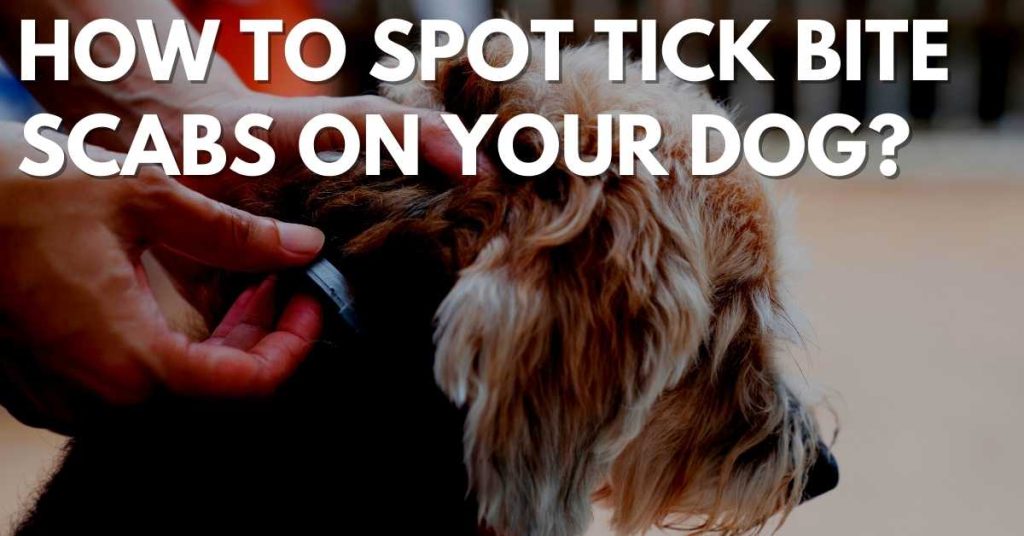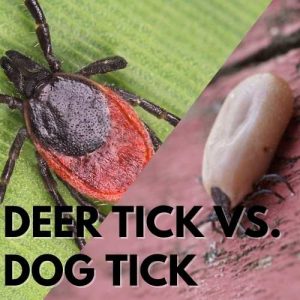
One of the most common signs that a tick has bitten your dog is the appearance of a small scab at the site of the bite. Ticks usually insert their mouth parts into the skin and then engorge themselves with blood, resulting in a small puncture wound. As the wound heals, it may form a scab.
By looking closely at their fur, you can easily tell whether your dog has a scab or a tick. Scabs are usually flat against the skin, and the ticks, on the other hand, stick out, especially as they grow in size.
If you notice a scab on your dog’s skin, carefully inspect it for any embedded ticks. If you find one, carefully remove it with tweezers, taking care not to crush the tick’s body. Be sure to disinfect the bite site afterward and keep an eye on it for any further signs of infection.
How To Check Dogs For Ticks?
If you are looking for the best way to check dogs for ticks, Stop!. There is no best way. Here are some tips on how to check your dog for tick.
- Ticks are often brown, black, or gray and prefer to hide in deep, dark, and warm regions, so they may be difficult to spot on dogs with longer and darker coats.
- Sweep your fingers from the head down your dog’s body fur to feel any bumps or lumps.
- If you feel anything unusual, part the fur in that area and look closely for telltale signs.
- Inspect your dog’s neck, under the collar or harness, around the eyes and eyelids, inside and around the ears, front legs, armpits, tail, groin area, and toes.
- Ticks cling to the dog’s skin and like to feed themselves in one location. Depending on how long they’ve been there, they can grow from the size of a pinhead to a pea as they feed on your dog’s blood.
- If your dog has a tick, you should feel a little bump with your fingertips or comb. Stop to check what the bump is before taking part of the tick’s body out (pulling part of the tick’s body out can be dangerous to your dog).
- Check the skin for any red or inflamed areas, and keep an eye on your dog for symptoms of persistent scratching or licking in specific areas. This behavior could signify that a tick has attached itself to your dog’s skin in this location.
Even if your dog is protected from fleas and ticks, it’s still good to check for ticks after it has gone outside, especially during tick season. Getting your dog groomed will help with the hunt. This is the best way to check dogs for ticks.
Do Ticks Leave Scabs On Dogs?
Yes. Ticks leave scabs on dogs. You can possibly find a scab on your dog after the tick fell out from the dog. The bite area might form a wound leading to a scab. It is usually red or brown and covers the wound. The blood in the wounded area starts to clot after a wound. The clot prevents further blood loss and any harmful things inside the damage. The clot dries up and forms a scab. The scab also helps in the natural healing of the wound.
How Are Scabs Formed On Dogs?
- Scabs can be formed in your dog due to variety of reasons.
- One among them is the tick bite.
- A Tick bite is a wound that leaves a scab on the dog’s skin.
- The significance of the tick bite scab is that it looks black.
- The dogs scratch their skin when the ticks bite due to itching and might leave a scab.
- A Tick removed forcefully from a dog’s skin can also leave a scab at times.
Scab After Tick Bite On Dog
A Tick bite or removal leaves a scab on the dog’s skin. The tick bite creates skin irritation for the dog and causes them to scratch. The scratch sometimes leaves crusty scabs on the skin. Tick scabs generally heal on their own. It takes around 3 to 14 days to heal itself.
The scab area must be kept clean to avoid further infection. You can clean the scab area using a disinfectant. You have to observe the scab area regularly. If the scab does not disappear after an extended period, you must consult a vet to check for tick-induced diseases.
You can use tick repellents to prevent tick scabs. Your outdoors should also be kept clean by cutting down long grass. You should examine your dog’s skin regularly.
Black Scab On Dog After A Tick Bite
Black scabs appear due to a cut or a wound. It could also appear because of a tick bite. But you can possibly draw the difference between the black scab due to rash or wound and a tick bite. Yes, if the scab is black and tiny, then it is probably due to tick bite.
Black scabs appear when the platelets rush to the affected area when there is a cut in the skin. The platelets clots to stop the bleeding. The platelets dry and become a scab. The scab is reddish brown and turns black over a while.
Generally, Black stabs are not life-threatening. You should consult a Vet if the black scabs continue to persist. Once confirmed about tick bite, do not hesitate to take necessary medical actions to protect your dog from tick infections.
Infected Tick Scab On Dog – How Does It Look Like?
The Tick Scabs might get infected at times. An abscess is the common visible symptom of the infected scab. Other than this, you can observe the following signs also:
- Redness or Inflammation – You can observe swollen or reddened skin around the wound, indicating the infection.
- Fever – Your dog’s temperature might increase above 104 degrees Fahrenheit
- Lethargy – Your dog might not be able to walk or be its usual self. It would prefer to lie down
- Lack of appetite – Your dog will not be interested in its food.
- Hair Loss – There will be a loss of hair around the wound
- Bleeding or Oozing skin – Blood or Bodily fluids might Ooze out from the infected area
You must consult your Vet immediately if you suspect the scab is infected.
Does Tick Bite/Scab Make My Dog Sick?
Ticks, fleas, and other parasites can make your dog sick. The bacteria in their mouth can cause infections, often transmitted through blood or respiratory secretions, and may be life-threatening if left untreated for too long. They can be carriers of Lyme disease, Ehrlichia, anaplasmosis, babesiosis, Bartonella, and Rocky Mountain spotted fever. Several of these disorders’ manifestations might become rather serious without adequate treatment.
Lyme disease can significantly impact kidney function, resulting in Lyme nephropathy. The kidneys are being destroyed, and the animal will eventually die.
It’s crucial to remember that not all ticks transmit illnesses, and some diseases are only found in certain parts of the country. Tick-borne infections can be avoided by following the correct preventative measures.
How To Remove A Tick From A Dog?
Tick bites can be painful and dangerous for dogs. If you feel a tick has bitten your dog, it is vital to remove the tick as soon as possible. The best way to pull out a tick is with a pair of tweezers. Here are some fastest ways to remove ticks from dogs.
If you encounter a tick on your dog,
- Make sure you have a good grasp of the tick. You don’t want to squish the tick’s body, as this can cause disease-carrying bacteria to be released into your dog’s bloodstream.
- Gently pull the tick straight out. Avoid jerking or twisting the tick, which can also cause the tick’s body to break open.
- After removing the tick, clean the affected area with a disinfectant and wash your hands thoroughly. Be sure to dispose of the tick in a sealed container so that it cannot bite anyone else.
- If you feel uneasy removing the tick yourself, take your dog to the vet as soon as possible. They will be able to remove the tick safely and give your dog any necessary treatment.
- You may also want to watch the area for a few days to ensure the occurrence of no infection.
Ticks can cause infection in as little as 36 hours, so getting rid of them as soon as possible is crucial. Tick removal is a simple process, and most pet owners can comfortably follow the above steps.
If you find a scab on your dog that looks like it might be from a tick bite, it’s essential to take a closer look.
- Check to see if the scab is in an area where your dog would typically be exposed to ticks. There’s a good chance that the scab is from a tick bite.
- Look for other signs of a tick bite, such as redness or swelling. If you see any of these signs, it’s essential to take your dog to the vet for a checkup.
Tick bites usually scab over and heal on their own, but it’s important to keep an eye on them in case of infection. If you come across any signs of infection, such as redness, swelling, or pus, take your dog to the vet. Infected tick bites can be serious, so it’s better to be safe than sorry.
How To Prevent Ticks On Dogs?
It’s crucial to stick to your tick-prevention routine. Oral drugs, topical treatments, and natural insect/tick killers for the home, yard, and collars are all options for tick prevention. Ask your veterinarian to assist you in deciding which option is best for you and your dog. The region, lifestyle, and breed of the dog all play a role.
Here are a few things you can do to help prevent your dog from getting ticks:
- Keep your dog’s environment clean by regularly sweeping and mopping your floors and vacuuming your furniture and carpets. It would be best to wash your pet’s bedding at least weekly in hot water.
- Use tick repellents on your dog. Many repellents are available in the market, so talk to your veterinarian about which one is best for your pet.
- Keep your dog away from wooded areas, long grasses, and leaf litter, all known to harbor ticks. Examine your dog carefully for ticks after every walk or time spent outside if you live in an area where ticks are abundant.
- Have your vet check your dog for ticks at least once a year. It is the best way to ensure that your pet is tick-free.
The method that works for one dog may not work for another, so you’ll have to experiment to find the ideal method for your dog. With that being stated, there are a plethora of wonderful natural repellents on the market, but make sure to double-check the ingredient list with your veterinarian.
Finally, cleanliness is the key to preventing ticks, bugs, and parasites. Soap and water are the best first line of defense against the dirt, muck, and moisture that ticks thrive in.
How Long Does It Take To Heal Ticks Scab?
While some dogs may be able to heal the scab quickly, others may take longer. If you’re wondering how long it takes for a tick bite scab to heal on your dog, the answer may depend on several factors.
One of the most important factors is the size of the scab. If the scab is large, it will take longer to heal. Another factor is whether or not your dog has any allergies to tick bites. If your dog is allergic to ticks, the scab will take longer to heal. Finally, your dog’s age can also play a role in how long it takes for the scab to heal. Younger dogs tend to heal faster than older dogs.
If you’re concerned about the speed of healing of your dog’s tick bite scab, it’s always best to consult with your veterinarian. They will be able to provide you with the best advice on managing the scab and how long it will take to heal entirely.
The Takeaway
Spotting a tick bite scab on your dog is not always easy, but there are a few things you can look for. First, check for any redness or swelling around the bite. If the area is red and swollen, your dog may be bitten by a tick. You may also see a small scab or crusty area around the bite. If you feel a tick has bitten your dog, it’s important to trace and remove the tick as soon as possible. The longer the tick lingers on your dog, the higher the danger of sickness.



